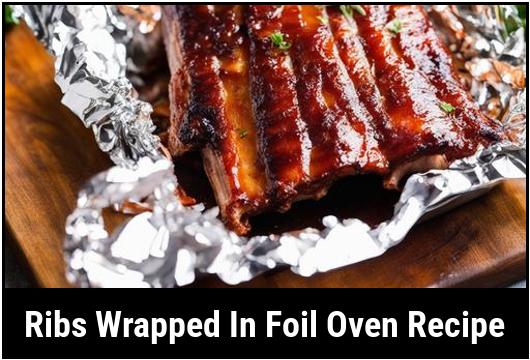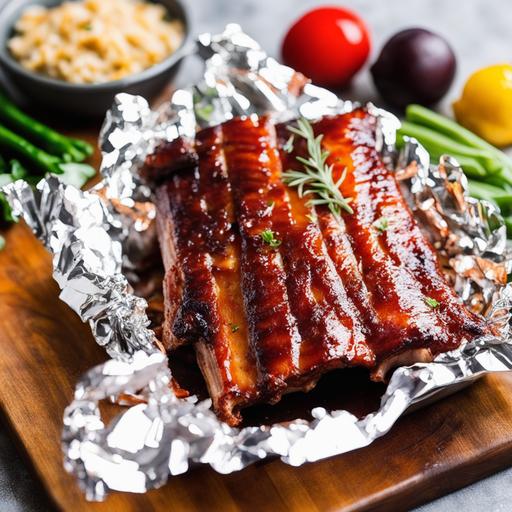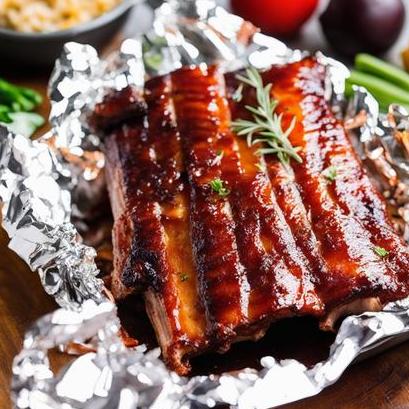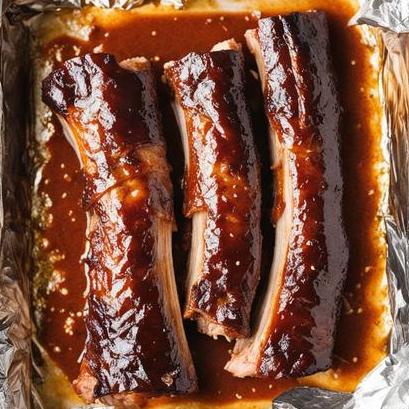
The Ultimate Guide To Ribs Wrapped In Foil Oven Recipe
Cooking ribs wrapped in foil in the oven is a delightful way to achieve tender, juicy ribs with minimal effort. This method helps seal in moisture and flavors, resulting in succulent meat that practically falls off the bone. Whether you’re hosting a backyard barbecue or craving a comforting meal at home, this recipe is sure to satisfy your cravings. In this comprehensive guide, we’ll explore the science behind cooking ribs wrapped in foil, discuss ingredient selection, delve into the preparation process, and provide step-by-step instructions for creating mouthwatering ribs in your oven.
Food Science Of Cooking Ribs Wrapped In Foil In An Oven
Understanding the science behind cooking ribs wrapped in foil is essential for achieving optimal results. When ribs are enclosed in foil, they create a steamy environment that helps break down tough connective tissues while retaining moisture. This process, known as braising, occurs as the ribs cook low and slow in the oven. The foil acts as a barrier, preventing the meat from drying out while allowing it to tenderize gradually. Additionally, the enclosed environment enhances flavor infusion, as the juices and seasonings mingle and penetrate the meat, resulting in a more flavorful end product.
Choosing Ingredients
Selecting high-quality ingredients is paramount when preparing ribs wrapped in foil. Here’s what you’ll need:
Ribs
- Choose fresh, high-quality ribs from a reputable butcher or grocery store. St. Louis-style ribs or baby back ribs are popular options, each offering its own unique flavor and texture.
Seasonings
- Opt for a flavorful rub or seasoning blend to enhance the taste of the ribs. Common ingredients include brown sugar, paprika, garlic powder, onion powder, cumin, chili powder, and black pepper.
Barbecue Sauce (optional)
- If you prefer saucy ribs, select a barbecue sauce that complements the flavor profile of your rub. Whether you prefer sweet and tangy or spicy and smoky, there’s a barbecue sauce to suit your taste preferences.
Foil
- Choose heavy-duty aluminum foil to ensure the ribs are properly sealed during cooking. This will help prevent any steam or juices from escaping, resulting in tender, moist ribs.
Preparing Ingredients

Proper preparation is key to achieving delicious ribs wrapped in foil. Follow these steps to prepare your ingredients:
Preparing The Ribs
- Start by rinsing the ribs under cold water and patting them dry with paper towels.
- Remove the thin membrane from the back of the ribs by sliding a butter knife under the membrane and lifting it away from the meat. This step allows for better seasoning penetration and tenderization.
Seasoning The Ribs
- Generously apply your chosen seasoning rub to both sides of the ribs, ensuring they are evenly coated. Massage the rub into the meat to enhance flavor absorption.
- For added flavor, allow the seasoned ribs to marinate in the refrigerator for at least 1-2 hours, or preferably overnight. This allows the flavors to meld and penetrate the meat.
Preparing The Foil Packet
- Tear off a large piece of heavy-duty aluminum foil, enough to fully encase the ribs.
- Place the seasoned ribs in the center of the foil and fold the edges upwards to create a tight seal. Ensure there are no gaps or openings in the foil packet to prevent steam from escaping.
Optimal Oven Cooking Temperature & Timing
Achieving perfectly cooked ribs requires careful attention to temperature and timing. Follow these guidelines for optimal results:
Oven Temperature
- Preheat your oven to 275°F (135°C). This low temperature allows the ribs to cook slowly and evenly, resulting in tender, juicy meat.
Cooking Time
- The cooking time for ribs wrapped in foil will vary depending on the size and thickness of the ribs. As a general rule of thumb, plan to cook the ribs for 2.5 to 3 hours. However, it’s essential to check for doneness using visual and tactile cues.
Doneness Indicators
- When the ribs are ready, they should be tender and easily pierced with a fork or probe thermometer. The meat should also begin to pull away from the bones, indicating that it’s cooked to perfection.
Ribs Wrapped In Foil Oven Recipe
Now that you’ve prepared your ingredients and preheated your oven, it’s time to dive into the cooking process. Follow these step-by-step instructions for mouthwatering ribs:
Ingredients
- 1 rack of ribs (St. Louis-style or baby back)
- Seasoning rub of your choice
- Barbecue sauce (optional)
Instructions
- Preheat your oven to 275°F (135°C) and prepare the ribs as described in the previous section.
- Once the ribs are seasoned and wrapped in foil, place them on a baking sheet or roasting pan to catch any drips.
- Transfer the ribs to the preheated oven and bake for 2.5 to 3 hours, or until the meat is tender and easily pierced with a fork.
- Optional: During the last 30 minutes of cooking, brush the ribs with barbecue sauce for added flavor and caramelization.
- Once the ribs are done, carefully remove them from the oven and let them rest for a few minutes before serving.
- To serve, unwrap the foil packet and transfer the ribs to a cutting board. Slice between the bones and serve with your favorite sides and additional barbecue sauce, if desired.
Cooking ribs wrapped in foil in the oven is a foolproof method for achieving tender, flavorful ribs that are sure to impress your family and friends. By understanding the science behind the cooking process, selecting high-quality ingredients, and following proper preparation and cooking techniques, you can create restaurant-quality ribs in the comfort of your own home. Whether you’re hosting a summer barbecue or simply craving a hearty meal, this recipe is sure to become a favorite in your household. So fire up your oven, grab your foil, and get ready to enjoy delicious ribs that are fall-off-the-bone tender every time!
Doneness Checks

Cooking ribs wrapped in foil in the oven offers a convenient alternative to traditional outdoor grilling, allowing you to enjoy deliciously tender ribs regardless of the weather or your access to outdoor cooking equipment. By sealing the ribs in foil, you create a steamy, oven-safe environment that helps lock in moisture and infuse the meat with flavor.
Before diving into the recipe, it’s essential to understand the importance of selecting the right type of ribs. Pork ribs are the most popular choice for this cooking method, with options including baby back ribs, spare ribs, and St. Louis-style ribs. Each variety offers its own unique flavor profile and meat-to-fat ratio, so feel free to experiment to find your favorite.
Achieving the perfect level of doneness is crucial when cooking ribs. Undercooked ribs can be tough and chewy, while overcooked ribs will be dry and lacking in flavor. Fortunately, there are several methods you can use to check for doneness:
Visual Inspection
One of the simplest ways to gauge the doneness of your ribs is by visually inspecting them. Fully cooked ribs will have pulled back slightly from the ends of the bones, and the meat will be tender and easy to pull apart with a fork.
Temperature Check
Using a meat thermometer is the most accurate way to determine whether your ribs are done. Insert the thermometer into the thickest part of the meat, making sure to avoid contact with the bone. Pork ribs are safe to eat when they reach an internal temperature of 145°F (63°C), although many prefer to cook them to a slightly higher temperature for optimal tenderness.
Bend Test
Another popular method for checking doneness is the bend test. Simply pick up the rack of ribs with a pair of tongs and give it a gentle bend. If the meat begins to crack slightly and the bones start to separate, the ribs are likely done.
Undercooking
Undercooked ribs are a common pitfall for inexperienced cooks, but with the right techniques, you can easily avoid this issue. Here are a few signs that your ribs are undercooked:
- Tough, chewy texture: Undercooked ribs will be tough and difficult to chew, with a rubbery consistency.
- Pinkness near the bone: While a slight pink hue is normal in cooked pork, if you notice significant pinkness near the bone, your ribs may still be undercooked.
- Resistance to bending: Fully cooked ribs should bend easily when picked up with tongs. If they remain stiff and unyielding, they likely need more time in the oven.
If you discover that your ribs are undercooked, simply return them to the oven and continue cooking until they reach the desired level of tenderness. Be sure to monitor them closely to prevent overcooking.
Overcooking
Overcooking can quickly turn tender, succulent ribs into a dry, flavorless disappointment. To avoid this culinary catastrophe, keep an eye out for the following signs of overcooked ribs:
- Dry, stringy texture: Overcooked ribs will be dry and stringy, with a texture reminiscent of shredded cardboard.
- Charred or burnt edges: Excessive cooking can cause the edges of the ribs to become charred or burnt, resulting in a bitter, unpleasant taste.
- Falling off the bone: While fall-off-the-bone tenderness is often desirable, ribs that are overcooked to the point of disintegration lack the juicy, meaty texture that makes them so enjoyable.
If you suspect that your ribs are overcooked, there may still be hope for salvaging them. Try brushing them with a generous amount of barbecue sauce or other flavorful liquid to help rehydrate the meat and add moisture. Alternatively, you can chop the overcooked ribs into bite-sized pieces and use them as a topping for salads, tacos, or pasta dishes.
Troubleshooting

Even the most seasoned chefs encounter occasional challenges when cooking ribs wrapped in foil in the oven. Fortunately, many common issues have simple solutions. Here are a few troubleshooting tips to help you overcome any obstacles:
Tough, Chewy Ribs
If your ribs turn out tough and chewy, they may have been undercooked or cooked at too low a temperature. To remedy this, return them to the oven and continue cooking until they reach the desired level of tenderness. You can also try increasing the oven temperature slightly to speed up the cooking process.
Dry, Flavorless Ribs
Dry, flavorless ribs are often the result of overcooking or insufficient seasoning. To add moisture and flavor, brush the ribs with barbecue sauce or another flavorful liquid before returning them to the oven. You can also try wrapping them in foil and cooking them at a lower temperature to prevent further drying.
Uneven Cooking
Uneven cooking can occur if the ribs are not arranged evenly on the baking sheet or if the oven temperature is uneven. To promote more even cooking, rotate the ribs halfway through the cooking process and consider using a convection oven, which circulates hot air more efficiently.
By addressing these common issues proactively, you can ensure that your ribs turn out perfectly every time.
Recipe Variations
While the basic technique for cooking ribs wrapped in foil in the oven remains the same, there are countless variations and flavor combinations to explore. Here are a few ideas to get you started:
Asian-Inspired Ribs
Marinate the ribs in a mixture of soy sauce, ginger, garlic, and brown sugar before wrapping them in foil and baking. Serve with a side of steamed rice and stir-fried vegetables for a flavorful Asian-inspired meal.
Spicy Barbecue Ribs
Brush the ribs with a spicy barbecue sauce made with chipotle peppers, cayenne pepper, and smoked paprika before wrapping them in foil and baking. The combination of heat and smokiness will tantalize your taste buds and leave you reaching for seconds.
Honey Mustard Ribs
Coat the ribs in a tangy honey mustard glaze before wrapping them in foil and baking. The sweetness of the honey and the tanginess of the mustard create a mouthwatering flavor combination that pairs perfectly with the rich, savory taste of the ribs.
Feel free to experiment with different seasonings, marinades, and sauces to create your own unique twist on this classic dish.
Cooking ribs wrapped in foil in the oven is a simple yet satisfying way to enjoy tender, flavorful ribs without the need for outdoor grilling equipment. By following the tips and techniques outlined in this guide, you can achieve perfect results every time, whether you’re cooking for a crowd or simply indulging in a delicious meal at home. So fire up your oven, grab a rack of ribs, and get ready to savor the mouthwatering goodness of this timeless favorite.
Flavour Enhancement Tips
Ribs, characterized by their juicy meat and tantalizing aroma, are a culinary delight enjoyed by many across the globe. While traditionally associated with outdoor barbecues, oven cooking offers a convenient alternative, especially when outdoor grilling isn’t an option. By wrapping the ribs in foil, you can seal in moisture and flavor, resulting in tender, succulent meat that melts in your mouth.
This oven recipe provides a hassle-free method for achieving restaurant-quality ribs in the comfort of your own kitchen.
The key to unforgettable ribs lies in the depth and complexity of flavors infused into the meat. Here are some tips to enhance the flavor profile of your ribs:
1. Marinade Or Rub
Before wrapping the ribs in foil, marinate them in a flavorful sauce or apply a dry rub generously. Marinades can consist of a variety of ingredients, such as soy sauce, brown sugar, garlic, and spices, while dry rubs often include a blend of herbs and spices like paprika, cumin, and chili powder. Allow the ribs to marinate for at least a few hours, or preferably overnight, to allow the flavors to penetrate the meat.
2. Liquid Infusion
Adding a liquid to the foil packet can further enhance the flavor and moisture of the ribs. This can be anything from broth and beer to apple juice or cider vinegar. The liquid creates steam inside the packet, helping to tenderize the meat while infusing it with additional flavor.
3. Aromatics
Incorporating aromatics such as onions, garlic, herbs, and citrus zest into the foil packet can impart aromatic undertones to the ribs. These ingredients release their flavors during the cooking process, infusing the meat with a rich and fragrant essence.
Texture Enhancement Tips

Achieving the perfect texture is crucial for a satisfying rib-eating experience. Here’s how to ensure your ribs are tender and juicy:
1. Low And Slow Cooking
To achieve tender, fall-off-the-bone ribs, it’s essential to cook them at a low temperature for an extended period. This slow-cooking method allows the connective tissues in the meat to break down gradually, resulting in a tender texture. Aim for a temperature of around 275°F (135°C) and cook the ribs for 2.5 to 3 hours, or until they are fork-tender.
2. Foil Wrapping
Wrapping the ribs tightly in foil helps to lock in moisture and create a steamy environment that promotes tenderization. Ensure that the foil is sealed securely to prevent any steam from escaping during the cooking process. This method also prevents the ribs from drying out, resulting in a juicy and flavorful end product.
3. Uncovering For Crisping
While the foil helps to retain moisture and tenderize the ribs, it can also inhibit the development of a crispy exterior. To achieve the perfect balance of tenderness and crispiness, unwrap the foil during the final stage of cooking and allow the ribs to cook uncovered for an additional 15-20 minutes. This will allow the surface of the ribs to caramelize and develop a delicious crust.
Cooking At Different Temperatures
Adjusting the cooking temperature can yield different results in terms of texture and flavor. Here’s how to tailor the cooking temperature to your preferences:
1. Low And Slow (275°F/135°C)
Cooking the ribs at a low temperature (around 275°F or 135°C) for an extended period is ideal for achieving tender, fall-off-the-bone meat. This method allows for gentle and gradual cooking, resulting in perfectly cooked ribs with a melt-in-your-mouth texture.
2. High And Fast (350°F/175°C)
If you’re short on time and prefer a slightly firmer texture, you can opt for a higher cooking temperature. Cooking the ribs at 350°F (175°C) will expedite the cooking process while still producing deliciously tender meat. However, be mindful not to overcook the ribs, as they may become dry if exposed to high heat for too long.
3. Combination Method
For the best of both worlds, you can utilize a combination cooking method. Start by cooking the ribs at a low temperature (around 275°F or 135°C) to tenderize the meat, then finish them off at a higher temperature (350°F or 175°C) to achieve a crispy exterior. This approach ensures that the ribs are both tender and flavorful, with a satisfying caramelized crust.
Cooking Tips
Mastering the art of cooking ribs in the oven requires attention to detail and careful execution. Here are some tips to ensure success:
1. Preheat The Oven
Before placing the ribs in the oven, preheat it to the desired temperature to ensure even cooking. This allows the ribs to cook evenly from the start, resulting in consistent texture and flavor.
2. Use Quality Ingredients
Selecting high-quality ribs and flavorful marinades or rubs is essential for achieving delicious results. Opt for fresh, well-marbled ribs and quality seasonings to enhance the overall flavor and texture of the dish.
3. Monitor Internal Temperature
To ensure that the ribs are cooked to perfection, use a meat thermometer to monitor the internal temperature. The ideal temperature for cooked ribs is around 190-203°F (88-95°C). Insert the thermometer into the thickest part of the meat, avoiding contact with bone or fat.
4. Resting Period
Allow the ribs to rest for a few minutes after removing them from the oven. This allows the juices to redistribute within the meat, resulting in a juicier and more flavorful end product. Tent the ribs loosely with foil to keep them warm while resting.
Serving Suggestions
Once your ribs are cooked to perfection, it’s time to indulge in their irresistible flavor. Here are some serving suggestions to complement your delicious dish:
1. Classic BBQ Spread
Serve the ribs with classic barbecue sides such as coleslaw, baked beans, and cornbread for a hearty and satisfying meal. Drizzle the ribs with extra barbecue sauce for an added burst of flavor.
2. Fresh Salad
Balance out the richness of the ribs with a crisp and refreshing salad. Opt for a simple green salad with vinaigrette dressing or a tangy coleslaw for a vibrant accompaniment.
3. Roasted Vegetables
Roasted vegetables such as sweet potatoes, Brussels sprouts, or asparagus make excellent side dishes for ribs. Seasoned with herbs and spices, roasted veggies add depth and variety to your meal.
4. Corn On The Cob
Grilled or boiled corn on the cob is a classic accompaniment to ribs. Brushed with butter and sprinkled with salt and pepper, corn on the cob adds a sweet and savory element to your plate.
Conclusion
Mastering the art of cooking ribs wrapped in foil in the oven opens up a world of culinary possibilities. With the right techniques and ingredients, you can achieve tender, flavorful ribs that rival those cooked on the grill. By following the tips and methods outlined in this guide, you’ll be well-equipped to create restaurant-quality ribs in the comfort of your own kitchen. So, gather your ingredients, preheat your oven, and get ready to indulge in a mouthwatering feast that will delight your senses and satisfy your cravings. Cheers to delicious ribs and happy cooking!
FAQS
How Long Should I Cook Ribs Wrapped In Foil In The Oven?
To achieve tender and juicy ribs, you should cook them for approximately 2 to 2.5 hours at a temperature of 275°F (135°C). However, the exact cooking time may vary depending on the thickness of the ribs and your desired level of doneness.
Should I Remove The Membrane Before Wrapping The Ribs In Foil?
Yes, it is recommended to remove the membrane from the back of the ribs before wrapping them in foil. The membrane is tough and can prevent the flavors and seasonings from penetrating the meat. To remove it, gently loosen a corner with a butter knife, then grab with a paper towel and peel off in one smooth motion.
What Type Of Ribs Are Best For This Recipe?
This recipe works well with both baby back ribs and spare ribs. Baby back ribs are smaller and leaner, with a delicate flavor, while spare ribs are larger, meatier, and slightly fattier. Choose the type that suits your preferences and availability.
Can I Add A Barbecue Sauce While Wrapping The Ribs In Foil?
It is not recommended to add barbecue sauce while wrapping the ribs in foil. The sauce may burn or become overly sticky during the extended cooking time. Instead, it is best to apply the sauce during the last 30 minutes of cooking or when grilling the ribs after they are done in the oven.
Can I Open The Foil To Check The Ribs During Cooking?
It is better to avoid opening the foil too often during cooking, as this can cause steam and heat to escape, prolonging the cooking time and potentially drying out the ribs. It is advisable to rely on time and temperature guidelines rather than frequent peeking to ensure optimal results.


